 ,
is the crisp set of all ordered pairs such that the first element in each pair
is a member of X and the second element is a member of Y.
Formally,
,
is the crisp set of all ordered pairs such that the first element in each pair
is a member of X and the second element is a member of Y.
Formally,
A crisp relation represents the presence or absence of association, interaction, or interconnectedness between the elements of two or more sets. This concept can be generalized to allow for various degrees or strengths of relation or interaction between elements. Degrees of association can be represented by membership grades in a fuzzy relation in the same way as degrees of set membership are represented in the fuzzy set. In fact, just as the crisp set can be viewed as a restricted case of the more general fuzzy set concept, the crisp relation can be considered to be a restricted case of the fuzzy relations.
Cartesian product
The Cartesian product of two crisp sets X and Y, denoted
by
 ,
is the crisp set of all ordered pairs such that the first element in each pair
is a member of X and the second element is a member of Y.
Formally,
,
is the crisp set of all ordered pairs such that the first element in each pair
is a member of X and the second element is a member of Y.
Formally,

The Cartesian product can be generalized for a family of crisp sets
It is possible for all sets
Relation among sets
A relation among crisp sets
so for relations among sets
Each crisp relation R can be defined by a characteristic function that
assigns a value 1 to every tuple of the universal set belonging to the relation
and a 0 to every tuple that does not belong. Thus,
The membership of a tuple in a relation signifies that the elements of the
tuple are related or associated with one another.
A relation can be written as a set of ordered tuples. Another convenient way of
representing a relation
Each element of the first dimension i1 of this array
corresponds to exactly one member of X1, each element of the
first dimension i2 to exactly one member of
X2, and so on. If the n-tuple
Just as the characteristic function of a crisp set can be generalized to allow
for degrees of set membership, the characteristic function of a crisp relation
can be generalized to allow tuples to have degrees of membership within the
relation.
Thus, a fuzzy relation is a fuzzy set defined on the Cartesian product
of crisp sets
A fuzzy relation can also conveniently be represented by an
n-dimensional membership array whose entries correspond to
n-tuples in the universal set. These entries take values representing
the membership grades of the corresponding n-tuples.
Examples
Let R be a crisp relation among the two sets X={dollar,
pound, franc, mark} and Y={United States, France, Canada, Britain,
Germany}, which associates a country with a currency as follows:
R(X,Y) = {(dollar,United
States),(franc,France),(dollar,Canada),
(pound,Britain),(mark,Germany)}
This relation can also be represented by the following two dimensional
membership array:
Let R be a fuzzy relation among the two sets the distance to the
target X={far, close, very close} and the speed of the car
Y={very slow, slow, normal, quick, very quick}, which represents the
relational concept "the break must be pressed very strong".
This relation can be written in list notation as
R(X,Y) = {0/(far, very slow) + .3/(close, very slow) +
.8/(very close, very slow)
+ 0/(far, slow) + .4/(close, slow) + .9/(very close, slow)
+ 0/(far, normal) + .5/(close, normal) + 1/(very close, normal)
+ .1/(far, quick) + .6/(close, quick) + 1/(very close, quick)
+ .2/(far,very quick)+ .7/(close,very quick)+ 1/(very close,very quick)}
This relation can also be represented by the following two dimensional
membership array:
Subsequence
Consider the Cartesian product of all sets in the family
and each sequence (r-tuple, r < n)
where
Let
Projection
Given a relation
Then,
where
Example
Consider the sets X1={far, close },
X2={slow, quick} and X3={small, tall} and
the trenary fuzzy relation
+ .3/(far, quick, small) + .4/(close, quick, small)
+ .5/(far, slow, tall) + .6/(close,slow, tall)
+ .7/(far, quick, tall) + .8/(close, quick, tall) }
defined on
Let
R1,2 = { .5/(far, slow) + .6/(close, slow)
+ .7/(far, quick) + .8/(close, quick) }
R1,3 = { .3/(far, small) + .4/(close, small)
+ .7/(far, tall) + .8/(close, tall) }
R2,3 = { .2/(slow, small) + .4/(quick, small)
+ .6/(slow, tall) + .8/(quick, tall) }
R1 = { .7/(far) + .8/(close) }
R2 = { .6/(slow) + .8/( quick) }
R3 = { .4/(small) + .8/(tall) }
Cylindric extension
Another operation on relations which is in some sense an inverse to the
projection, is called a cylindric extension. Let X and Y
denote the same families of sets as employed in the definition of projection.
Let R be a relation defined on the Cartesian product of sets in the
family Y, and let
The cylindric extension produces the largest fuzzy relation (in the
sense of membership grades of elements of the extended Cartesian product) that
is compatible with the given projection. Such a relation is the least specific
of all relations compatible with the projection. The cylindric extension thus
maximizes the nonspecificity in deriving the n-dimensional
relation from one of its r-dimensional projections (r <
n). That is, it guarantees that no information that is not included in the
projection is employed in determining the extended relation.
Example
Membership functions of cylindric extensions of the first three projections of
the previous example with respect to X are shown below. For instance of
calculating the membership functions:
R1,2 = { .5/(far, slow) + .6/(close, slow)
+ .7/(far, quick) + .8/(close, quick) }
+ .7/(far, quick, small) + .8/(close, quick, small)
+ .5/(far, slow, tall) + .6/(close,slow, tall)
+ .7/(far, quick, tall) + .8/(close, quick, tall) }
R1,3 = { .3/(far, small) + .4/(close, small)
+ .7/(far, tall) + .8/(close, tall) }
+ .3/(far, quick, small) + .4/(close, quick, small)
+ .7/(far, slow, tall) + .8/(close,slow, tall)
+ .7/(far, quick, tall) + .8/(close, quick, tall) }
R2,3 = { .2/(slow, small) + .4/(quick, small)
+ .6/(slow, tall) + .8/(quick, tall) }
+ .4/(far, quick, small) + .4/(close, quick, small)
+ .6/(far, slow, tall) + .6/(close,slow, tall)
+ .8/(far, quick, tall) + .8/(close, quick, tall) }
Cylindric closure
Relations that can be reconstructed from one of their projections by the
cylindric extension exist, but they are rather rare. It is more common that a
relation can be exactly reconstructed from several of its projections by taking
the set intersection of their cylindric extensions. The resulting relation is
usually called a cylindric closure.
When projections are determined by the max operator
the min operator is normally used for the set intersection. Hence, given a set
of projections
where
Example
The cylindric closure of the first three projections (cylindric extensions) of
the previous example is the following fuzzy ternary relation:
cyl{R1,2, R1,3, R2,3} =
{ .2/(far, slow, small) + .2/(close, slow, small)
+ .3/(far, quick, small) + .4/(close, quick, small)
+ .5/(far, slow, tall) + .6/(close,slow, tall)
+ .7/(far, quick, tall) + .8/(close, quick, tall) }
We can see that the cylindric closure is almost the same as the original
relation. The only error in the cylindric closure involvs the triple (far,
slow, small), which has a membership grade .1 in R and .2 in the
cylindric closure. Hence, the three projections do not capture the original
relation fully but approximate it quite well. Another example of the
approximation of a relation by its cylindric closures is shown graphically on
Fig. 1.3.1.
Fig. 1.3.1. Approximation of the relation R by its cylindric closures
Any relation between two sets X and Y is known as a binary
relation. It is usually denoted by R(X,Y).
In addition to membership matrices, another useful representation of binary
relations R(X,Y) are sagittal diagrams. Each of the
sets X,Y is represented by a set of nodes in the diagram; nodes
corresponding to one set are clearly distinguished from nodes representing the
other set. Elements of
The symbol R representing a binary relation is often used in the
following alternative way: we write xRy when
Example
The domain of a relation
The domain of a crisp binary relation is written as
domR(X,Y) and is defined as the crisp subset of X
whose members participate in the relation. Formally,
If R(X,Y) is a fuzzy relation, its domain is the
fuzzy set domR(X,Y) whose membership function is defined
by
for each
The range of a relation
The range of a crisp binary relation R(X,Y) is
denoted by ranR(X,Y) and is defined as the crisp subset of
Y whose members participate in the relation. Thus,
When R(X,Y) is a fuzzy relation, its range is the
fuzzy set ranR(X,Y) whose membership function is defined
by
for each
The range of a relation
The height of a fuzzy relation R is a number h(R)
defined by
that is, the largest membership grade attained by any pair
The inverse of a relation
The inverse of a crisp relation R(X,Y) is written
as R-1(X,Y) and is a subset of
where
Clearly,
For a fuzzy relation R(X,Y), the inverse fuzzy
relation R-1(X,Y) is defined by
A membership matrix
for any binary fuzzy relation.
Example
Let R(X,Y) be a fuzzy relation on
The inverse of R(X,Y) is then specified by the membership
matrix
where
The Composition of Binary Relations, the Fuzzy Max-Min Composition
Consider two crisp binary relations P(X,Y) and
Q(Y,Z) defined with a common set Y. The
composition of these two crisp relations is denoted by
and is defined as a subset R(X,Z) of
Just as the classical set operations such as union and intersection have a
variety of generalizations for fuzzy sets, the composition operation for fuzzy
relations can take several forms. The most common of these is the max-min
composition. Denoted again by
for all
If the composition for crisp relations P(X,Y) and
Q(Y,Z) is thought of as representing the existence of a
relational chain between elements of X and Z, then the max-min
composition for fuzzy relations can be interpreted as indicating the strength
of such a relational chain. This strength is represented by the membership
grade of the pair
Example
Consider two binary relations P(X,Y) and
Q(Y,Z) specified by their sagittal diagrams in Fig. 1.3.3.
Let
Note that the pairs of
Composition of binary relations are conveniently performed in terms of
membership matrices of the relations. Let
Observe that the same elements of MP and
MQ are used in the calculation of
MR as would be used in the regular multiplication of
matrices, but the product and sum operations are here replaced with the min and
max operations, respectively.
Example
The following matrix equations illustrate the max-min composition:
The Relational Join of Binary Relations
A similar operation on two binary relations, which differs from the composition
in that it yields triples instead of pairs, is known as the relational
join. Let us denote it by
For crisp relations P(X,Y) and
Q(Y,Z), it is defined as
For fuzzy relations P(X,Y) and
Q(Y,Z), the relational join corresponding to the max-min
composition is defined by
We can see that the join operation forms a ternary relation from two binary
relations. This is a major difference from the operation of composition, which
produces another binary relation. In fact, the max-min composition is obtained
by aggregating appropriate elements of the corresponding join by the max
operator. Formally,
Observe that although a composition can be determined from the corresponding
join, the reverse determination cannot be made, that is, the join cannot be
determined from the composition.
Example
The join
 and denoted either by
and denoted either by  .
Elements of the Cartesian product of n crisp sets are n-tuples
.
Elements of the Cartesian product of n crisp sets are n-tuples
 Thus,
Thus,
 to be equal, that is, to be a single set X. In this case, the Cartesian
product of a set X with itself n times is usually denoted by
to be equal, that is, to be a single set X. In this case, the Cartesian
product of a set X with itself n times is usually denoted by
 .
. is a subset of the Cartesian product
is a subset of the Cartesian product  It is denoted either by
It is denoted either by
 or by the abbreviated form
or by the abbreviated form
 .
Thus,
.
Thus, ,
, ,
the Cartesian product
,
the Cartesian product
 represents the universal set. Because a relation is itself a set, the basic set
concepts such as containment or subset, union, intersection, and complement can
be applied without modification to relations.
represents the universal set. Because a relation is itself a set, the basic set
concepts such as containment or subset, union, intersection, and complement can
be applied without modification to relations.
 involves an n-dimensional membership array:
involves an n-dimensional membership array:
 ,then
,then
 ,
may have varying degrees of membership within the relation. The membership
grade is usually represented by a real number in the closed interval
,
may have varying degrees of membership within the relation. The membership
grade is usually represented by a real number in the closed interval
 and indicates the strenght of the relation present between the elements of the
tuple.
and indicates the strenght of the relation present between the elements of the
tuple.
U.S. France Canada Britain Germany
dollar 1 0 1 0 0
pound 0 0 0 1 0
franc 0 1 0 0 0
mark 0 0 0 0 1
very slow slow normal quick very quick
far 0 0 0 .1 .2
close .3 .4 .5 .6 .7
very close .8 .9 1 1 1
 .
For each sequence (n-tuple)
.
For each sequence (n-tuple)

 ,
let y be called a subsequence of x if and only if
,
let y be called a subsequence of x if and only if
 .
. denote that y is a subsequence of x.
denote that y is a subsequence of x. ,
denote the projection of R that disregards all variables in
X except those in set
,
denote the projection of R that disregards all variables in
X except those in set
 is a fuzzy set (relation) whose membership function is defined on the Cartesian
product of sets in Y by the equation
is a fuzzy set (relation) whose membership function is defined on the Cartesian
product of sets in Y by the equation
 is the membership function of the given n-ary relation R.
is the membership function of the given n-ary relation R. =
{ .1/(far, slow, small) + .2/(close, slow, small)
=
{ .1/(far, slow, small) + .2/(close, slow, small) .
. .
Then,
.
Then, denote the cylindric extension of R into sets Xi (
denote the cylindric extension of R into sets Xi (
 )
that are in X but not in Y. Then,
)
that are in X but not in Y. Then, .
.
 =
{ .5/(far, slow, small) + .6/(close, slow, small)
=
{ .5/(far, slow, small) + .6/(close, slow, small) = { .3/(far, slow, small) + .4/(close, slow, small)
= { .3/(far, slow, small) + .4/(close, slow, small) = { .2/(far, slow, small) + .2/(close, slow, small)
= { .2/(far, slow, small) + .2/(close, slow, small) ,
, of a relation,
of a relation,
 denotes the cylindric closure based on the projections.
denotes the cylindric closure based on the projections.

 with nonzero membership grades in R(X,Y) are represented
in the diagram by lines connecting the respective nodes. These lines are
labeled with the value of the membership grade
with nonzero membership grades in R(X,Y) are represented
in the diagram by lines connecting the respective nodes. These lines are
labeled with the value of the membership grade
 .
An example of the sagittal diagram together with the corresponding membership
matrix is shown in Fig. 1.3.2.
.
An example of the sagittal diagram together with the corresponding membership
matrix is shown in Fig. 1.3.2. ;
for fuzzy relations, we write
;
for fuzzy relations, we write
 when
when
 .
.
Fig.
1.3.2. Sagittal diagram together with the corresponding membership matrix


 .
Thus, each element of set X belongs in the domain of R to the
degree equal to the strenght of its strongest relation to any member of set
Y.
.
Thus, each element of set X belongs in the domain of R to the
degree equal to the strenght of its strongest relation to any member of set
Y.

 .
Therefore, the strength of the strongest relation that each element of Y
has to an element of X is equal to the degree of that element's
membership in the range of R.
.
Therefore, the strength of the strongest relation that each element of Y
has to an element of X is equal to the degree of that element's
membership in the range of R.
 ,
then the relation is called normal; otherwise it is called
subnormal.
,
then the relation is called normal; otherwise it is called
subnormal. such that
such that
 .
.
 .
. .
. representing R-1(X,Y) is the transpose of the
matrix
representing R-1(X,Y) is the transpose of the
matrix
 for R(X,Y), that is, the rows of
for R(X,Y), that is, the rows of
 equal the columns of
equal the columns of
 and the columns of
and the columns of
 equal the rows of
equal the rows of
 .
Clearly,
.
Clearly,
 and
and
 such that
such that

 denotes the transponse of
denotes the transponse of
 .
.
 ,
such that
,
such that
 if and only if there exists at least one
if and only if there exists at least one
 .
It follows from this definition of composition that the following three
properties are satisfied for binary relations P, Q, R:
.
It follows from this definition of composition that the following three
properties are satisfied for binary relations P, Q, R:
 ,
this operation is defined by
,
this operation is defined by
 .
This operation satisfies the same three properties just listed for the
composition of crisp relations.
.
This operation satisfies the same three properties just listed for the
composition of crisp relations. in the composition. The strength of each chain equals the strength of its
weakest link; and the strength of the relation between elements x and
z is then the strength of the strongest chain between them.
in the composition. The strength of each chain equals the strength of its
weakest link; and the strength of the relation between elements x and
z is then the strength of the strongest chain between them. .
is represented by the membership function specified in Fig. 1.3.3. For
example,
.
is represented by the membership function specified in Fig. 1.3.3. For
example,
 that have nonzero membership grades in the composition
that have nonzero membership grades in the composition
 are those joined by lines intersecting at a common element of Y in Fig.
1.3.3.
are those joined by lines intersecting at a common element of Y in Fig.
1.3.3.
Fig.
1.3.3. Composition and join of binary relations
 be membership matrices of binary relations such that
be membership matrices of binary relations such that
 .
We can then write, using this matrix notation,
.
We can then write, using this matrix notation,

 .
. .
. .
. .
. of relations P and Q given in Fig. 1.3.3. is represented by the
membership function specified in the same figure. To convert this join into the
corresponding composition
of relations P and Q given in Fig. 1.3.3. is represented by the
membership function specified in the same figure. To convert this join into the
corresponding composition
 by using the equation
by using the equation
 ,
the two indicated pairs of values of
,
the two indicated pairs of values of
 in Fig. 1.3.3. are aggregated by the max operator. For instance,
in Fig. 1.3.3. are aggregated by the max operator. For instance,